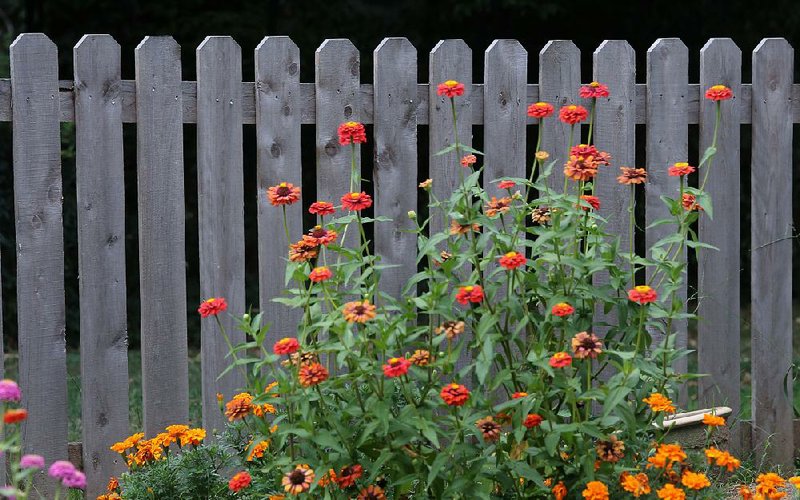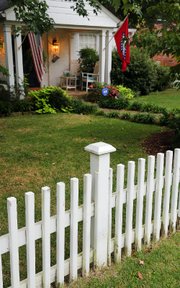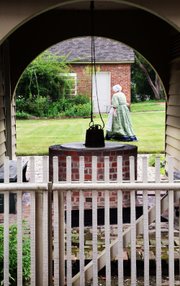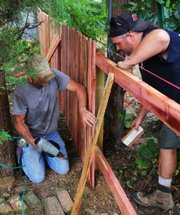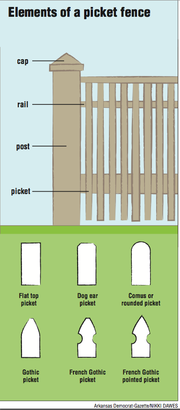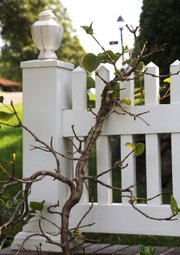I never expected anyone to take care of me, but in my wildest dreams and juvenile yearnings, I wanted a house with the picket fence from June Allyson movies. I knew that was yearning like one yearns to fly.
-- poet Maya Angelou
The Oxford American-English Dictionary describes a picket fence thusly:
"A wooden fence made of spaced uprights connected by two or more horizontal rails."
The simple structure was originally created to mark a property's boundaries and/or to keep animals in or out. But in the United States, it represents more, as the dictionary's North American version's second definition reveals: "A picket fence as a symbol of middle-class domesticity and contentment."
Picket fences, also known as paling fences, are popular in the United States, where they have been used since America's Colonial era. The fences arrived with early settlers who used them as property boundaries and to keep livestock in yards or out of gardens.
An abundance of wood meant there was a whole lot of materials, says Bill Worthen, executive director of the Historic Arkansas Museum in Little Rock. Picket fences and split-rail fences surround the historic property.
Originally, animals were allowed to roam free and graze openly.
"Until the more modern livestock laws were passed, people built the fences to protect their plants and gardens," Worthen says.
Swanee Bennett, the museum's deputy director and chief curator, says early in the Arkansas frontier era, fences were built to keep other people's livestock out rather than your own in. Arkansas' livestock laws regulating domestic
animals didn't begin until the early part of the 20th century, he says. Those laws required owners to keep domesticated livestock within the owner's property.
In the 1820s and 1830s, the era in which the museum's structures were built, picket fences were crafted from flat sawed boards. The earliest fences were utilitarian, but later ones became more decorative. By the late 1800s, homeowners often ordered their fences from catalogs.
The staff at the Historic Arkansas Museum make the shaped fences, Bennett says, adding that sometimes the fence's wooden pales or pickets are whitewashed; other times they are left natural.
"It's a never-ending project," he says. "It seems we're always replacing a pale or the baseboard or kick board at the bottom, which is decorative and keeps animals from rooting underneath it."
Picket fences serve as a decorative way to contain pets and children without blocking views. The fence's vertical slats allow for a visual feeling of openness.
The standard picket fence is 36 to 48 inches tall with evenly spaced boards affixed vertically to a horizontal top rail and bottom rail. The fence is attached to fence posts, installed upright into the ground. The top of each picket is usually tapered (often called a "dog-eared picket") or pointed. A variety of design options include rustic, Colonial, Victorian and modern.
Traditionally, picket fences were made of wood and painted white or whitewashed. Now they are often stained or left natural, allowing the wood to age. The wood used may be treated, untreated or one that is naturally resistant to insect and rot. Other options include vinyl, aluminum and polyvinyl chloride (PVC).
Marvin Fletcher, owner of Century Fence Co. in Little Rock, calls picket fences "the fence everybody wants but hardly anybody actually gets anymore."
Fletcher gives reasons: a picket fence not being compatible with the home's architectural style, zoning regulations, line-of-sight issues, a property line too far from the curb.
"A lot of times, the homeowner doesn't think about the property line being 10 to 12 feet from the curb," he says.
JoAnne Jennings recently chose to rebuild the wooden picket fence that surrounds the backyard of her Little Rock home because it was authentic to the Cape Cod-style house.
Fletcher, who has been building residential and commercial fences in central Arkansas for nearly 50 years, says he believes Eastern red cedar, an Arkansas product, is the best choice. The life expectancy a homeowner can expect from wood -- regardless of whether it is naturally resistant, treated, painted or stained -- is 20 to 25 years, he says.
"Painting doesn't stabilize the wood and it doesn't increase the life of the fence," Fletcher says. Rot occurs where the boards touch one another, and paint can't reach those places.
Fletcher recommends that those wanting the longest possible life from their fence use PVC, and he practices what he preaches. His home's porch hand rails are made of PVC.
"It's virtually maintenance-free."
But with colored PVC, he says, the hue can fade over time.
"It will probably last 50 to 60 years," Fletcher says. "The most you'll ever have to do with it is maybe occasionally wash it."
Thad Luther's Little Rock home is surrounded by a classic picket fence made of PVC.
"I chose this because it's maintenance-free and there's no painting involved," Luther says. "All I have to do is occasionally clean it."
Fletcher declined to quote a figure for the cost of a picket fence because size, style and varieties available vary greatly.
As for painting the fence, Fletcher leaves that up to the owner.
"If we paint it, we're going to air-spray it, which would leave paint all over the lawn and nearby shrubs," he says. "Most people stain it or leave them natural. If you're going to hire a painter, I would really encourage you to get a PVC one instead." PVC fences usually cost twice as much as wood.
"There's just not that many people who paint their fence white anymore," he says.
Sharon Welch-Blair of Little Rock is an exception.
About 25 years ago, she and her husband, Bob Blair, bought and restored the historic Hornibrook Mansion at 2120 S. Louisiana St. in the Quapaw Quarter, where they operate their award-winning Empress bed and breakfast.
The couple originally lived in the house, but they bought and moved into a smaller historic house at the corner of 22nd and Center streets.
The couple is noted for attention to detail in restoring, decorating and furnishing the Empress, but the decision to add a wooden picket fence with ornate archways over the front and side entrances to the front of the smaller personal residence was more than ornamental.
"There's maybe 6 feet from the home's front steps to the sidewalk," Welch-Blair says. "There wasn't much of a yard there, and I felt like there wasn't much separation from me and someone walking down the street.
"I feel like my picket fence makes the statement 'This is mine. If you're my guest, you can enter, but otherwise, 'Keep out.' It's a territorial thing."
"In the downtown historic district, you can't have fences taller than 40 inches," Welch-Blair says. But there's no rule against adding wooden lattice in some areas, so along the sides and back of the house, the couple added another 3 to 4 feet of wooden lattice work above those sections of the fence.
The addition of New Dawn roses creates an idyllic view when they're in bloom.
"This past spring, it looked just like a solid carpet of roses," Welch-Blair says.
HomeStyle on 09/12/2015
